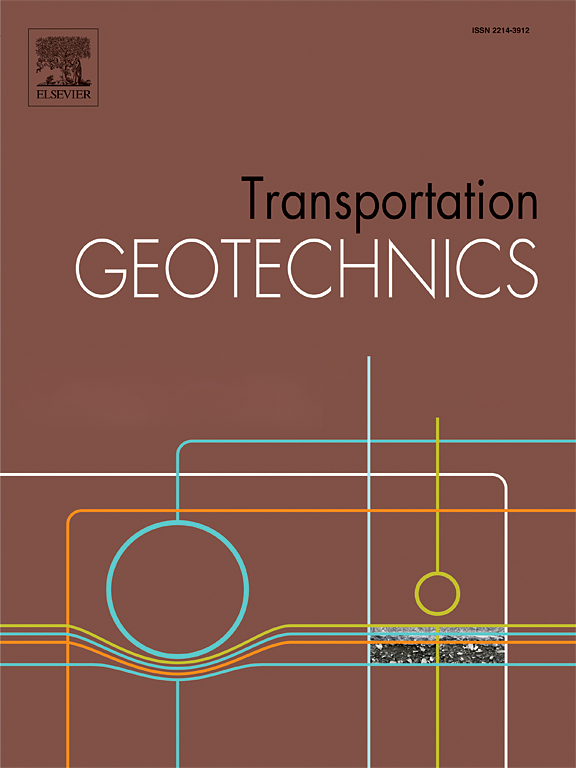可持续填充解决方案:回收EPS废料粉碎EPS粘土复合材料,以改善机械和压实性能
IF 4.9
2区 工程技术
Q1 ENGINEERING, CIVIL
引用次数: 0
摘要
膨胀聚苯乙烯(EPS)废物的处理和回收是一项重大挑战。虽然已有研究探讨了粗粒土与EPS废弃物混合作为轻质填筑材料的工程特性,但对细粒粘土的研究较少。本研究研究了三种不同塑性粘土的压实、强度和变形行为,混合0.5%至3.0%的破碎EPS。试验结果表明,在三种粘土中添加EPS碎料显著降低了最大干密度(MDD),使其适合于轻质填料。直剪试验表明,随着EPS碎料含量的增加,粘聚力降低,内摩擦角增大。无侧限抗压强度(UCS)随EPS含量的增加先升高,达到最佳EPS比例后降低。EPS碎料的加入也提高了粘土的和易性,降低了粘土的塑性指标。在此基础上,提出了一个确定最佳EPS碎料含量的框架,以实现不同粘性土强度与减重之间的最佳平衡。这项研究强调了EPS废物作为一种可持续添加剂的潜力,可以改善粘性土壤的特性,使其在建筑用途上更高效、更环保,特别是在道路路堤和路基稳定的运输岩土技术方面。本文章由计算机程序翻译,如有差异,请以英文原文为准。
Sustainable fill solutions: recycling EPS waste in shredded EPS-clayed soil composites for improved mechanical and compaction behaviour
The disposal and recycling of expanded polystyrene (EPS) waste pose significant challenges. Although previous research has explored the engineering characteristics of coarse-grained soils mixed with EPS waste for lightweight fill materials, limited attention has been given to fine-grained clayey soils. This study investigates the compaction, strength, and deformation behavior of three types of clayey soils with varying plasticity, mixed with 0.5% to 3.0% shredded EPS content. Experimental results indicate that the addition of shredded EPS to all three clayey soils significantly reduced the maximum dry density (MDD), making them suitable for lightweight fill applications. Direct shear tests revealed a decrease in cohesion and an increase in the angle of internal friction as the shredded EPS content increased. The unconfined compressive strength (UCS) initially increased with EPS content, then decreased after reaching an optimal EPS proportion. The addition of shredded EPS also enhanced the workability of the clayey soils, as evidenced by a reduction in their plasticity indices. Based on these findings, a framework is proposed to determine the optimum shredded EPS content, which provides the best balance between strength and reduced unit weight for different clayey soils. This research highlights the potential of EPS waste as a sustainable additive for improving the properties of clayey soils, making them more efficient and eco-friendly for construction purposes, particularly in transportation geotechnics for road embankments and subgrade stabilization.
求助全文
通过发布文献求助,成功后即可免费获取论文全文。
去求助
来源期刊

Transportation Geotechnics
Social Sciences-Transportation
CiteScore
8.10
自引率
11.30%
发文量
194
审稿时长
51 days
期刊介绍:
Transportation Geotechnics is a journal dedicated to publishing high-quality, theoretical, and applied papers that cover all facets of geotechnics for transportation infrastructure such as roads, highways, railways, underground railways, airfields, and waterways. The journal places a special emphasis on case studies that present original work relevant to the sustainable construction of transportation infrastructure. The scope of topics it addresses includes the geotechnical properties of geomaterials for sustainable and rational design and construction, the behavior of compacted and stabilized geomaterials, the use of geosynthetics and reinforcement in constructed layers and interlayers, ground improvement and slope stability for transportation infrastructures, compaction technology and management, maintenance technology, the impact of climate, embankments for highways and high-speed trains, transition zones, dredging, underwater geotechnics for infrastructure purposes, and the modeling of multi-layered structures and supporting ground under dynamic and repeated loads.
 求助内容:
求助内容: 应助结果提醒方式:
应助结果提醒方式:


